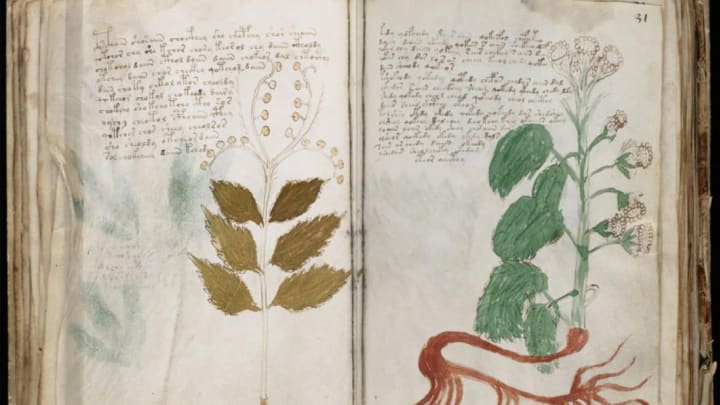Nicholas Gibbs, a historian and TV writer, claims he has solved one of the most confounding mysteries facing medieval scholars—one that has stumped researchers for at least 100 years. The handwritten Voynich manuscript was written in a still-unknown language (and alphabet) sometime around the 15th century, and features illustrations of plants that, for the most part, scientists haven't been able to identify. Theories about why it was created in the first place are still just speculative. But according to Gibbs, it's about women's health. In a recent issue of The Times Literary Supplement, Gibbs claims to have cracked the code to translating the Voynich.
The problem? Most scholars who specialize in medieval texts and linguistics say he's full of hot air, according to The Atlantic. If Gibbs had sent his theory to the Yale library that holds the manuscript, "they would have rebutted it in a heartbeat," the Medieval Academy of America's Lisa Fagin Davis, a professor of manuscript studies, told The Atlantic.
And here we go again. I've reviewed dozens of "solutions," and this one is just as unconvincing as the last 3,000. https://t.co/XGWqs2FoDc
— Lisa Fagin Davis (@lisafdavis) September 8, 2017
Seeing lots of stuff about the 'decipherment' of the Voynich Manuscript. Fellow linguists are *very* sceptical; they know abt decipherment. https://t.co/JGGjbh8vBY
— Philip Boyes (@PhilipJBoyes) September 8, 2017
The Voynich manuscript is named after Wilfrid Voynich, a rare book dealer who bought it in 1912, bringing it back into the public eye after it was forgotten for centuries. According to Gibbs, it is a “reference book of selected remedies lifted from the standard treatises of the medieval period, an instruction manual for the health and wellbeing of the more well to do women in society, which was quite possibly tailored to a single individual.” To support his translation, Gibbs argues that every letter in the manuscript is not just a letter, but a Latin abbreviation for a word, like how the ampersand was formed out of the letter "e" and "t," for the Latin "et," or "and."
Gibbs only provides two lines of decoded text to support his hypothesis, but in Latin, the decryption doesn't make grammatical sense. Many of his other revelations about the book, such as similarities in its illustrations to the "Balneis Puteolanis" ("The Baths of Pozzuoli")—a 13th-century poem that served as a guide to thermal baths—have already circulated among those studying the manuscript. Voynich obsessives have previously pointed out that the illustrations indicate that the manuscript probably has something to do with health, for instance. So even beyond the translation attempts, his theory on the whole isn't entirely groundbreaking.

For years, linguists, cryptographers, theoretical physicists, computer scientists, amateur detectives, and others have been working on breaking the code. During World War II, some of the U.S. Army's cryptanalysts even spent some of their off hours trying (in vain) to crack it.
Gibbs isn't the only person to claim he has solved at least part of the mystery. In 2014, British linguist Stephen Bax proposed a partial decoding of just 10 words, including the word for Taurus near an illustration of part of the constellation. Earlier this year, medievalist Stephen Skinner claimed to have pinned down the origins of the author, who he believes was a Jewish doctor in northern Italy. On the other hand, some scholars argue that the book is meaningless, and is just one big hoax.
If you want to get in on the search for the book's meaning (provided one exists), you don't need to flip through online scans of the manuscript. It was recently released in replica for the first time.
[h/t The Atlantic]
